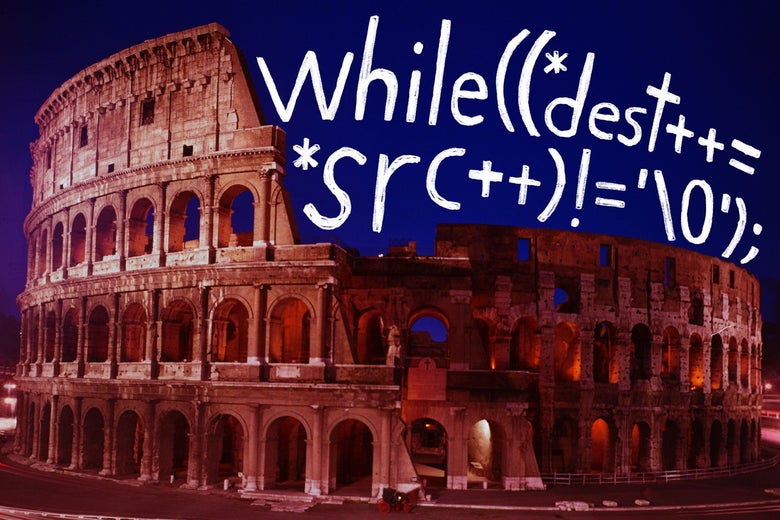- Mar 29, 2018
- 7,577
This is a sweet little article with some interesting historical tidbits.
______________________________________________
The Apollo 11 Lunar Module’s BAILOUT Code
Date: 1969
The code that kept the lunar module’s computer from running out of space in space
POODOO INHINT
CA Q
TS ALMCADR
TC BANKCALL
CADR VAC5STOR # STORE ERASABLES FOR DEBUGGING PURPOSES.
INDEX ALMCADR
CAF 0
ABORT2 TC BORTENT
OCT77770 OCT 77770 # DONT MOVE
CA V37FLBIT # IS AVERAGE G ON
MASK FLAGWRD7
CCS A
TC WHIMPER -1 # YES. DONT DO POODOO. DO BAILOUT.
TC DOWNFLAG
ADRES STATEFLG
TC DOWNFLAG
ADRES REINTFLG
TC DOWNFLAG
ADRES NODOFLAG
TC BANKCALL
CADR MR.KLEAN
TC WHIMPER
Digitized by Virtual AGC and MIT Museum, provided by the National Air & Space Museum
The Apollo Guidance Computer was a marvel: As Poppy Northcutt, who calculated Apollo’s return-to-Earth trajectories, told me, the AGC had less computing power than the greeting cards today that record a personal message. Yet it worked.
That limited power and storage space meant that tasks had to be carefully managed so the AGC was always focused on the most important jobs. If it ran out of space to perform tasks, that wouldn’t happen. The AGC software team knew there were eventualities they couldn’t plan for. So they created BAILOUT. When the computer was at risk of running out of space (or “overflow”), the AGC triggered BAILOUT to schedule less important data and operations so it could keep the vital ones up and running.
As the Eagle lander descended toward the moon’s surface, at 30,000 feet the AGC flashed a “1202” alarm, which neither Neil Armstrong nor the flight controller in Houston immediately recognized. But in less than 30 seconds, the computer experts in Mission Control relayed that the AGC software was doing just what it was supposed to: drop lower-priority work and restart the important jobs (so quickly that it was imperceptible to the crew). Armstrong and Buzz Aldrin would continue to get what they absolutely needed from the AGC to keep on the path to touchdown.
Overflow alarms would sound three more times before Armstrong uttered “the Eagle has landed,” but always because things worked as intended. The word “bailout” normally signals the failed end of a mission, but here it helped make humanity’s highest achievement a reality. —Ellen Stofan, John and Adrienne Mars Director, Smithsonian’s National Air and Space Museum
You can read the entire article here:

______________________________________________
The Apollo 11 Lunar Module’s BAILOUT Code
Date: 1969
The code that kept the lunar module’s computer from running out of space in space
POODOO INHINT
CA Q
TS ALMCADR
TC BANKCALL
CADR VAC5STOR # STORE ERASABLES FOR DEBUGGING PURPOSES.
INDEX ALMCADR
CAF 0
ABORT2 TC BORTENT
OCT77770 OCT 77770 # DONT MOVE
CA V37FLBIT # IS AVERAGE G ON
MASK FLAGWRD7
CCS A
TC WHIMPER -1 # YES. DONT DO POODOO. DO BAILOUT.
TC DOWNFLAG
ADRES STATEFLG
TC DOWNFLAG
ADRES REINTFLG
TC DOWNFLAG
ADRES NODOFLAG
TC BANKCALL
CADR MR.KLEAN
TC WHIMPER
Digitized by Virtual AGC and MIT Museum, provided by the National Air & Space Museum
The Apollo Guidance Computer was a marvel: As Poppy Northcutt, who calculated Apollo’s return-to-Earth trajectories, told me, the AGC had less computing power than the greeting cards today that record a personal message. Yet it worked.
That limited power and storage space meant that tasks had to be carefully managed so the AGC was always focused on the most important jobs. If it ran out of space to perform tasks, that wouldn’t happen. The AGC software team knew there were eventualities they couldn’t plan for. So they created BAILOUT. When the computer was at risk of running out of space (or “overflow”), the AGC triggered BAILOUT to schedule less important data and operations so it could keep the vital ones up and running.
As the Eagle lander descended toward the moon’s surface, at 30,000 feet the AGC flashed a “1202” alarm, which neither Neil Armstrong nor the flight controller in Houston immediately recognized. But in less than 30 seconds, the computer experts in Mission Control relayed that the AGC software was doing just what it was supposed to: drop lower-priority work and restart the important jobs (so quickly that it was imperceptible to the crew). Armstrong and Buzz Aldrin would continue to get what they absolutely needed from the AGC to keep on the path to touchdown.
Overflow alarms would sound three more times before Armstrong uttered “the Eagle has landed,” but always because things worked as intended. The word “bailout” normally signals the failed end of a mission, but here it helped make humanity’s highest achievement a reality. —Ellen Stofan, John and Adrienne Mars Director, Smithsonian’s National Air and Space Museum
You can read the entire article here:

